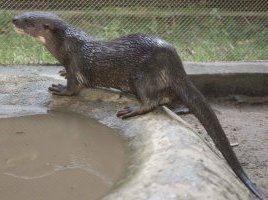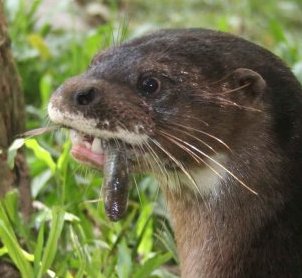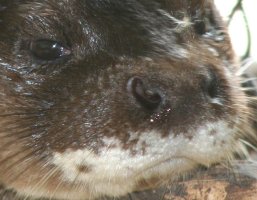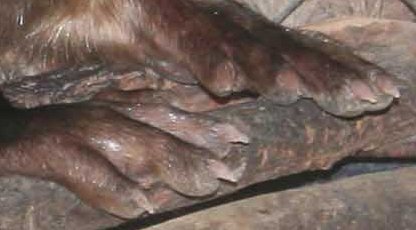Appearance and Anatomy of the Hairy-Nosed Otter
The information below comes from Harris (1968) and Wright et al (2008), All pictures are courtesy of Furget-Me-NotSummary
 A fish-eating otter, around the same size as a Eurasian Otter, living in flooded
tropical forests in south east Asia, this animal was thought to be extinct
but was rediscovered at four locations since 1998. These long, snaky otters,
which are about the same size as a Eurasian otter, really do have hairy noses!
A fish-eating otter, around the same size as a Eurasian Otter, living in flooded
tropical forests in south east Asia, this animal was thought to be extinct
but was rediscovered at four locations since 1998. These long, snaky otters,
which are about the same size as a Eurasian otter, really do have hairy noses!
Size
There are very few measurements available, but this appears to be the range for adult otters. Populations in different areas seem to differ in size - in the historical literature, Malaysian otters were considered larger than Sumatran ones.
| Sex | Total Length | Tail | Weight |
| Male | 95 - 133 cm (37 - 52") |
41 - 51 cm (16 - 20") |
5 -8 kg (11 - 17lb) |
In specimens from Thailand, the female has generally been found to be smaller than the male.
Head and Teeth

 The skull
of this species is more elongated than in other similar otters, with a shorter
relative distance from eye to nose, although this is not obvious in life.
The skull
of this species is more elongated than in other similar otters, with a shorter
relative distance from eye to nose, although this is not obvious in life.
The most important characteristic for identification is the hairy nose. The rhinarium is entirely covered in short, dark, dense fur and even on old museum specimens where the hair may have been lost or damaged, the underlying skin shows tiny pits rather than the smooth leathery textrue of other otter noses. The only bare skin on this otter's nose is teh upper edge of the nostrils.
The teeth are sturdy standard otter teeth. The dental formula is
Body
This species is the usual long, slender otter shape, but in life, move in a more serpentine manner than other otters - they seem to be particularly flexible and agile. Very little detailed anatomy is known, apart from an observation by Cantor (1846) that the alimentary canal was 2.7m (9') long with no caecum, which is odd seeing as the equivalent length for the Eurasian Otter (Lutra lutra) is about half as long. Like other otters, the kidneys are multilobed like cattle, and not smooth like pigs or lambs.Tail
The tail, which is about a third of the total length of the animal, is the usual tapered otter tail, rounded in cross-section but slightly flattened underneath.Legs and Paws
 This otter has fully-webbed
paws, with short, fine hairs on the upper surface, and naked beneath.
The claws are strong and well developed. Kanchanasaka
(2001) took plaster
casts of the footprints of this species, and found them hard to distinguish
from those of the Eurasian otter (Lutra lutra) which also lives in the same
habitat, although measurements showed them to be a little larger. The smooth-coated
otter (Lutrogale perspicillata) lives in the same area, but its tracks are
larger and more oval.
This otter has fully-webbed
paws, with short, fine hairs on the upper surface, and naked beneath.
The claws are strong and well developed. Kanchanasaka
(2001) took plaster
casts of the footprints of this species, and found them hard to distinguish
from those of the Eurasian otter (Lutra lutra) which also lives in the same
habitat, although measurements showed them to be a little larger. The smooth-coated
otter (Lutrogale perspicillata) lives in the same area, but its tracks are
larger and more oval.
Fur
The guard hairs are 12 - 14mm long and the underfur is 7 - 8mm long. The main colour of the hairy-nosed otter is usually dark chocolate brown, with the underside almost the same colour. The upper lip, chin and front part of the throat is white to yellow; the white 'moustache' is a good diagnostic feature. Some animals may be more chestnut in colour, but this may differ by location. The underfur is very pale.| Hairy-Nosed Otter |

